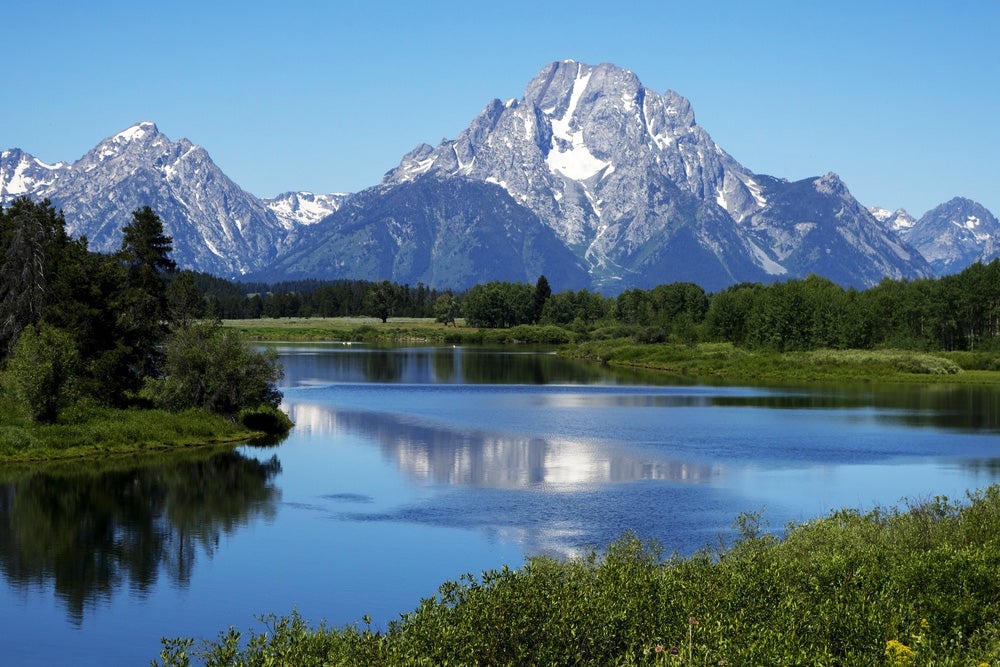Conservationists Challenge Federal Allowance for Wildlife Killing in Grand Teton National Park
National Park Service decision exposes iconic species living on private or state-owned land within National Parks to trophy hunting
Contact
Conservationists today filed a legal challenge to the National Park Service’s decision to reverse a long-standing agency policy by giving the State of Wyoming wildlife management authority on private and state inholdings inside Grand Teton National Park. The decision has already led to the killing of bison within park boundaries and exposes a host of park wildlife, including coyotes and foxes, to unregulated killing as vermin under state law.
The 310,000-acre Grand Teton National Park serves as a vital sanctuary for many species.
At issue is the Park Service’s November 2014 decision that federal regulations protecting wildlife on all lands inside National Parks, “regardless of ownership,” do not apply to 2,300 acres of inholdings within the boundaries of Grand Teton National Park. This unprecedented decision cedes wildlife management authority on such lands to the State of Wyoming and potentially exposes wildlife residing in Grand Teton—including bison, bobcats, coyotes, foxes, and, in the event of endangered species delisting, grizzly bears and wolves—to state-authorized hunting, baiting, and trapping. It also sets a dangerous precedent for the numerous other National Parks that contain inholdings, which are private or state-owned land parcels within federal park lands.
“It has been said that the National Parks are the best idea America ever had, but this may be the worst idea that the government has ever had about wildlife in the National Parks,” said Earthjustice attorney Timothy Preso, who represents Wyoming Wildlife Advocates and Defenders of Wildlife in the lawsuit. “We are acting to make sure that the bears, bison and other wildlife that Americans travel across the country to see in Grand Teton are protected, not shot or trapped.”
Photo courtesy of Thomas D. Mangelsen / www.mangelsen.com
Grizzly 399 and three of her cubs walk down Pilgrim Creek Road in Grand Teton National Park. Many travel to the park each year in hopes of seeing the 19-year-old bear, who has become well known for her tolerance and calm.
“Make no mistake, this decision raises the very real prospect that iconic wildlife such as Jackson Hole’s world-famous Grizzly Bear 399 and her family could be killed for trophies inside park boundaries if they cross on to one of the inholdings, and that threat is even more serious now that the government has proposed to remove Endangered Species Act protections for grizzly bears” said Kent Nelson of Wyoming Wildlife Advocates. “Other wildlife including red foxes, coyotes, raccoons and porcupines may be killed in unlimited numbers at any time by any lawful means on park inholdings under Wyoming’s authority.”
“The law is clear that wildlife is protected within National Parks even where there are private or state lands located within a park,” added McCrystie Adams of Defenders of Wildlife. “That position reflects the practical reality that National Park wildlife cannot be preserved if there is a patchwork of hunting authorizations inside park boundaries. We are asking a judge to enforce the law to protect Grand Teton and to prevent this terrible precedent from spreading to other National Parks across the country.”
Background
Since Congress established Grand Teton National Park in 1950, the National Park Service for more than 60 years exercised its authority to protect the park’s magnificent wildlife on all lands within park boundaries—including scattered state- and privately owned inholdings that exist inside the 310,000-acre park. But in November 2014, the Park Service abruptly reversed course and for the first time deferred to Wyoming’s assertion of state authority on the inholdings.
The Park Service’s decision leaves numerous wildlife species for which Grand Teton has served as a vital sanctuary—from bison and antelope to black bears and mountain lions—vulnerable to hunting, trapping, or baiting under Wyoming law should they cross the generally invisible boundaries that separate federally owned park lands from inholdings. As a result of this decision, at least three bison have been killed this winter on inholding land under Wyoming’s management and Wyoming has added new authorizations for hunting of elk, deer, and moose on the park inholdings.
The threat that hunting on the inholdings will lead to further loss of iconic park wildlife recently increased with the U.S. Fish and Wildlife Service’s March 11, 2016 proposal to remove the Greater Yellowstone Ecosystem’s grizzly bear population from the list of species protected under the Endangered Species Act. This proposed delisting action would hand jurisdiction over grizzly bears in Wyoming to state authorities. The combined effect of this proposed action and the Park Service’s November 2014 decision to give Wyoming authority over hunting on inholdings would enable Wyoming to authorize trophy hunting of grizzly bears on lands within the boundaries of Grand Teton National Park.

Additional Resources
About Earthjustice
Earthjustice is the premier nonprofit environmental law organization. We wield the power of law and the strength of partnership to protect people's health, to preserve magnificent places and wildlife, to advance clean energy, and to combat climate change. We are here because the earth needs a good lawyer.